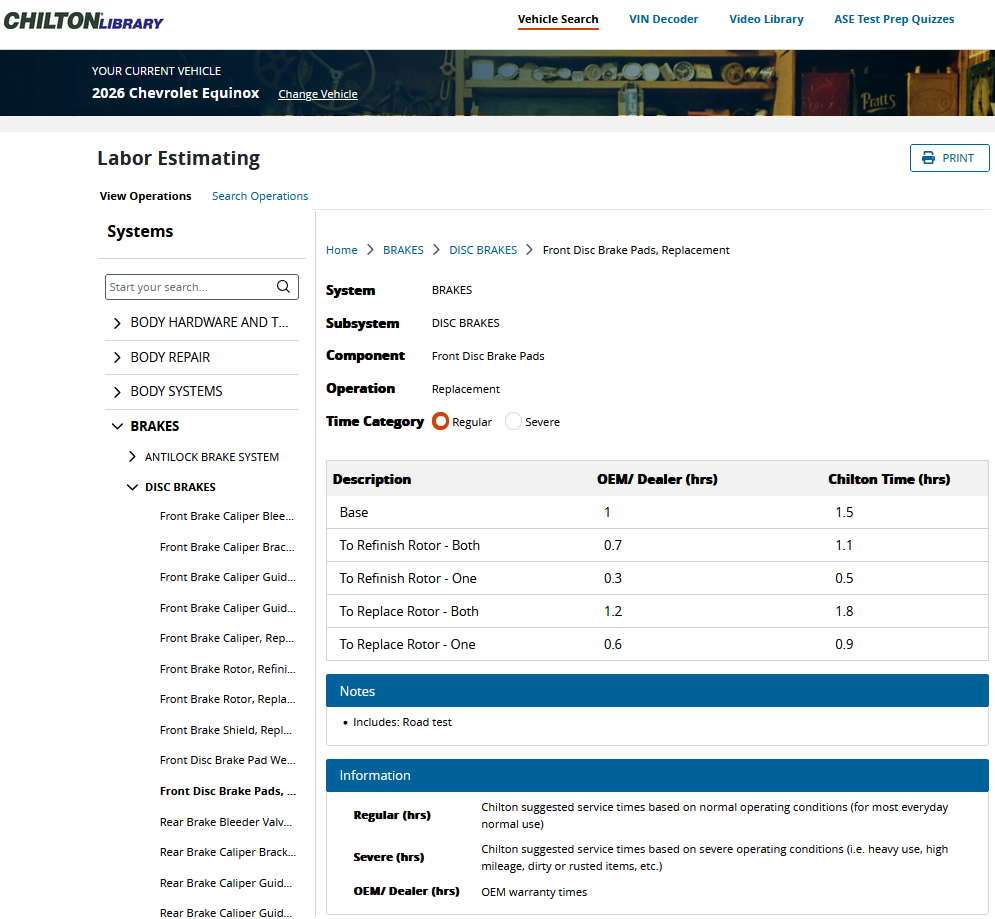|By Chilton Staff|
Sam hears a squeal when he steps on the brakes. It was faint a few weeks ago, but is now getting louder. Recognizing that the screech sound means the brake pads need to be replaced, he taps into ChiltonLibrary.
Sam has changed brake pads before, but not on this car. From the ChiltonLibrary homepage, he selects his 2015 Ford Edge, taps “Repair,” and opens the brake inspection and brake pad replacement procedures. The step-by-step procedures tell him what to expect.
How long will it take?
Sam wants to complete the work this weekend so he can drive the car to work on Monday. He taps the “Labor Estimating” tab and locates the brake pad replacement labor times to gain an understanding of how much time the procedure could take for his 2015 Edge.
Labor times really are the “secret sauce,” and Chilton makes otherwise difficult-to-access and costly data available in a way that’s easy to use.
What’s a labor time?
The time it takes to perform an auto repair or service is called the “flat rate,” or labor time. But where do labor times come from? Each automaker conducts time studies to create predetermined labor times for every service and repair, specific to the year, make, and model vehicle, sometimes even for specific components.
Not all labor times are equal. Automaker, aka original equipment manufacturer (OEM), labor times are the gold standard for vehicles under warranty. The ChiltonLibrary knowledgebase includes OEM labor times.
Why do automakers create labor times?
Automaker labor times set the amount of time they agree to pay their dealers for work on vehicles under warranty. By multiplying the labor time by the hourly labor rate, the OEM calculates a predictable labor cost for each warranty job. For example, the labor cost to replace brake pads with a 2-hour labor time at an hourly rate of $130 would be $260. Whether the job actually takes less or more time, the OEM still pays the same labor time.
What factors go into a labor time?
When setting labor times, automakers assume the work will be done by dealer technicians with OEM training, tools, parts, and the experience of performing the task multiple times. In addition, OEM labor times are based on vehicles under warranty, which are by definition, newer.
The OEM time assumes the job is conducted flawlessly, with all special tools at hand, no waiting for parts, or other issues. That’s why do-it-yourselfers would struggle to complete tasks in OEM timeframes. Even independent techs, and dealer techs working on a different make, are at a disadvantage to meet OEM labor times.
That’s where Chilton times come in. Do-it-yourselfers and repair shops have relied upon Chilton’s proprietary labor time estimates for decades. Chilton times work from OEM benchmarks and account for factors like lack of OEM equipment, tools, training, parts, and experience, as well as particular issues older vehicles have, such as wear, damage, dirt, rust, and modifications.
The times are a guide
Labor times give an indication of how long a job can be expected to take. With that baseline, auto repair shops and do-it-yourselfers can estimate their labor times, given the circumstances. The times are a guide, not an absolute.
GM and Ford Labor Estimating Updates
ChiltonLibrary recently updated OEM and Chilton labor estimating times for Buick, Cadillac, Chevrolet, GMC, Ford, and Lincoln models. The screenshot below shows an excerpt from the 2026 Chevrolet Equinox front disc brake pads labor estimating times. Toggle the red “Time Category” button in the app to view the time estimates for severe operating conditions, such as towing, stop-and-go traffic, or high mileage.
Trusted auto repair labor times are highly sought after to estimate how long a repair or service should take. ChiltonLibrary provides this valuable information in an easy-to-use application.
If your library doesn’t currently subscribe, request a free trial or contact your Gale consultant.



